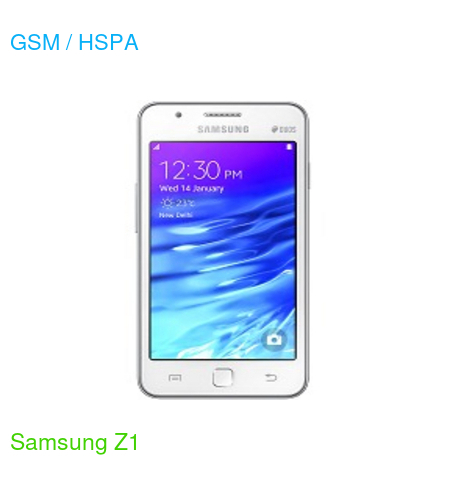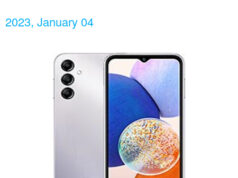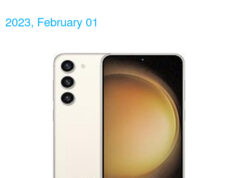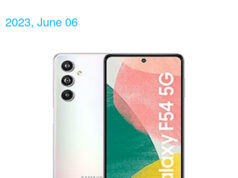| 📱 Samsung Z1 | NETWORK GSM / HSPA 2015, January. Released 2015, January GSM 850 / 900 / 1800 / 1900 – SIM 1 & SIM 2 |
| NETWORK | Technology GSM / HSPA |
| BODY | Dimensions 120.4 x 63.2 x 9.7 mm (4.74 x 2.49 x 0.38 in) |
| Weight | 112 g (3.95 oz) |
| SIM | Dual SIM |
| DISPLAY | Type PLS LCD |
| Size | 4.0 inches, 45.5 cm2 (~59.8% screen-to-body ratio) |
| Resolution | 480 x 800 pixels, 5:3 ratio (~233 ppi density) |
| PLATFORM | OS Tizen 2.3 |
| Chipset | Spreadtrum SC7727S |
| MEMORY | Card slot microSDXC (dedicated slot) |
| MAIN CAMERA | Single 3.15 MP Features LED flash Video 480p@15fps |
| SELFIE CAMERA | Single VGA Video |
| SOUND | Loudspeaker Yes 3.5mm jack Yes |
| COMMS | WLAN Wi-Fi 802.11 b/g/n |
| FEATURES | Sensors Accelerometer |
Specifications data description of this 📱Samsung Z1📱
Title: Unveiling the Samsung Z1: A Deep Dive into Its Specifications
Introduction
In January 2015, Samsung released the Samsung Z1, an entry-level smartphone powered by the Tizen OS. The Z1 was Samsung’s first Tizen-based device, designed to cater to budget-conscious consumers seeking a reliable and affordable smartphone. This blog post will explore the key features and specifications of the Samsung Z1, highlighting its design, network capabilities, display, performance, camera, sound, communications, features, and battery.
Lineup
The Samsung Z1 is a budget-friendly smartphone that marks Samsung’s entry into the Tizen OS ecosystem. As Samsung’s first Tizen-based device, the Z1 aimed to provide a competitive alternative to Android and iOS devices in the entry-level segment.
Design
The Samsung Z1 boasts a sleek and compact design, with dimensions of 120.4 x 63.2 x 9.7 mm (4.74 x 2.49 x 0.38 in) and a lightweight build of 112 g (3.95 oz). Its body is designed to fit comfortably in users’ hands, making it an ideal choice for those who prefer small-form-factor devices.
Specifications
🌐 Network: The Samsung Z1 supports both GSM and HSPA network technologies, offering a seamless connectivity experience.
📅 Launch: The device was released in January 2015, making it one of the earliest Tizen-based smartphones on the market.
🏋️ Body: Measuring 120.4 x 63.2 x 9.7 mm, the Z1 is both compact and portable.
🌈 Display: The Z1 features a 4.0-inch PLS LCD display, offering a resolution of 480 x 800 pixels and a density of 233 ppi, delivering a crisp visual experience.
🤖 OS: The Z1 runs on Tizen 2.3, providing a smooth and user-friendly interface that is both efficient and intuitive.
🛠️ Chipset: Under the hood, the device features the Spreadtrum SC7727S, ensuring reliable performance and power efficiency.
💪 CPU: The Z1 boasts a dual-core 1.2 GHz Cortex-A7 CPU, delivering a smooth and responsive user experience.
🖥️ GPU: The device’s Mali-400MP2 GPU handles graphical tasks, providing a seamless visual experience.
🧠 Memory: While the Z1 does not offer expandable memory, it features a dedicated microSDXC slot, supporting up to 128GB of storage for multimedia and files.
📷 Camera: The Z1 features a 3.15 MP rear camera and a VGA front camera, both offering LED flash capabilities for enhanced photography.
🔈 Sound: The device offers a loudspeaker and a 3.5mm jack, providing users with various audio output options.
📡 Comms: The Z1 features Wi-Fi 802.11 b/g/n capabilities, ensuring a stable and fast internet connection.
💡 Features: The device features an accelerometer, providing users with motion-based control and automation capabilities.
🔋 Battery: The Z1 comes equipped with a removable Li-Ion 1500 mAh battery, offering ample power for daily use.
Conclusion
The Samsung Z1 is an affordable and dependable smartphone powered by the Tizen OS. Its appealing design, network capabilities, display, performance, camera, sound, communications, and features make it an attractive option for budget-conscious consumers. With a wide range of preinstalled applications and a thriving Tizen app ecosystem, the Z1 provides users with an enjoyable and practical mobile experience. With that said, we invite our readers to leave a comment sharing their thoughts on the Samsung Z1 and discussing any questions or experiences they may have had with the device.
(This blog post has been generated based on the provided specifications table. To learn more about the device, please consult the manufacturer’s official resources or third-party reviews for additional details and user experiences.)







